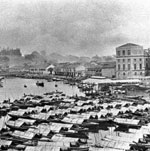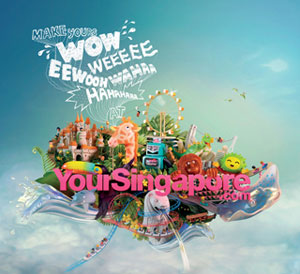
The British recognised in the 19th century the potential of Singapore...

FRONT PAGE
Site Search
About us
 

City brand Amsterdam
City brand Brasilia
City brand Bucharest
City brand Chicago
City brand Hong Kong
City brand Jakarta
City brand London
City brand Singapore
City brand Tokyo
US mayors on Twitter
Europe's top city brands
EUROCITIES branding report - a critical review
EUROCITIES on city branding
Cities into successful brand
Social media and government
Top level city domain names
Gallup's Soul of the City
Mayor of London
London City Hall

Worldwide | Elections | North America | Latin America | Europe | Asia | Africa |


























|
|
The Singapore brand offers
a thoroughly modern city
By Andrew Stevens
8 June 2011: Singapore as both an island entity and governed project, has long embedded branding practice into both of these elements. From the ‘Lion City’ free port of founder Sir Stamford Raffles in the 19th century, which became as Sir Winston Churchill later dubbed it the “Gibraltar of the East”, through to the modern-day independent city state Lee Kuan Yew guided under his tutelage from third world shantytown once populated by the “dregs” of Asia (as the city’s main paper referred to them) in 1965 to first world global hub today. While all brands and reputations are considered essential to success by their custodians, Singapore’s in particular, like the society itself, has been the subject of careful and considered engineering.
| History | Assets | Brand partners | Campaigns |
History
The island state has also long drawn on its paradoxical status as city-state, a nation which exists as a city in all but name which projects itself as Asian megacity alongside Hong Kong, Shanghai and Tokyo, but with the full trappings of nationhood enjoyed by neighbouring rivals Malaysia and Indonesia.
Equally however, it also tends to constantly negotiate the impact of its positive traits, such as enterprise culture, stable governance, corporate probity and low crime, which give rise to a notion of bland conformity as external identity. In a 1993 essay, novelist William Gibson dubbed it ‘Disneyland with the Death Penalty’, which dismissed the city as an anodyne financial hub with no character and lacking in creativity. While the corporatist state hardly acquitted itself of the charge by banning Gibson’s essay (since lifted), it has however made great strides in negotiating its soft infrastructure (or lack thereof alluded to by Gibson) by underscoring the pristine hard variety for which it has received extensive external recognition and acclaim by global bodies such as the World Bank.
For instance, while former leader Lee Kuan Yew felt compelled to outlaw gambling on the basis that it detracted from a national work ethic, the state has since proven flexible enough in its efforts to remain globally competitive by introducing ‘integrated resorts’ to allow for casinos to exist while retaining Lee’s vision of a “clean, green, safe and wholesome” Singapore. Equally, the state’s previously rigid codes on homosexuality were relaxed in order to attract and accommodate more foreign workers, as per the diversity prescriptions of Richard Florida’s ‘creative class theory’ which has received official backing since as early as 2004. As Koh Buck Song argues in his book Brand Singapore, the ‘nanny state’ is now more like to seek engagement for its own benefit than conflict or deterrence.
Singapore assets
In a 2007 speech to business leaders in the city, former UN representative Prof. Kishore Mahbubani argued that it has since exceeded all ‘world standards’ and summarised Singapore’s unique offer as:
• Infant mortality – lowest in the world
• Education – among top attainment and 95.4% literacy for adults
• Poverty – virtually no homeless or slums
• Healthcare – a life expectancy from birth of 79.9 years
• Housing – 90.9% home ownership among residents
• Economy – 8.1% average annual growth since 1965
• Political stability – not involved in any war or conflict since independence
• Ethnic cohesion – racially diverse society, absence of community tensions
• Environment – above average air quality and well resourced waste collection
• Culture – wide range of museums and arts institutions, growing film industry
Brand partners and stakeholders
The overarching aspects of Singapore’s branding are carefully and centrally directed from the upper echelons of the state under the auspices of the Cabinet, most significantly the Prime Minister’s Office. While external marketing and overseas campaigns are handled by the Singapore Tourism Board (STB, an agency of the Ministry of Trade and Industry), in effect the total sum of government efforts to perpetuate its on-brand message in order to single-mindedly accrue growth are carried out through a myriad of boards, state-owned (or dominated) companies, including its globally iconic Singapore Airlines, and community associations, ensuring this is almost reflected in the daily conduct of all employees and citizens. For instance, Singapore’s notoriously strict media laws have often been defended as conducive towards maintaining social harmony between various groups, but in recent years the authorities have begun to argue their retention is necessary in order to protect its image. Thus the stakeholder set is probably more extensive than in most cities, or at least their duties to the ‘brand’ are more entrenched and pronounced.
Campaigns
 In March 2010 the Singapore Tourism Board unveiled ‘YourSingapore’, its new destination brand following the half decade of ‘Uniquely Singapore’. Rather than a break with or successor to Uniquely Singapore, which traded on the island’s accentuated characteristics, YourSingapore is touted as an evolution of the former, a postmodern deconstruction instead focusing on what the visitor alone is seeking rather than what rival destinations might have to offer. In that sense it could be seen as ‘all things to all men’ but what possibly differentiates it from past campaigns is its concentration on the internet and social media, albeit with backup channels such as TV and hosted advertising where necessary. In March 2010 the Singapore Tourism Board unveiled ‘YourSingapore’, its new destination brand following the half decade of ‘Uniquely Singapore’. Rather than a break with or successor to Uniquely Singapore, which traded on the island’s accentuated characteristics, YourSingapore is touted as an evolution of the former, a postmodern deconstruction instead focusing on what the visitor alone is seeking rather than what rival destinations might have to offer. In that sense it could be seen as ‘all things to all men’ but what possibly differentiates it from past campaigns is its concentration on the internet and social media, albeit with backup channels such as TV and hosted advertising where necessary.
An ultimately more pervasive and possibly better known campaign, not least as it enjoys non-bureaucratic legitimacy and grounding, is that of the state airline and its ‘Singapore Girl’ advertisements featuring its female cabin crew and their instantly recognisable sarong uniform as integral to the company marque and its visuals, as much as the tailfin logo. Despite an array of industry awards and consistent success for the world’s second largest carrier, the use of such a ‘regressive’ stereotype of Asian women has elicited some unfavourable views, although the airline and state alike recognise the overall benefit of its continued use as an integral element of the brand. Ultimately while the airline brand may not bring all to Singapore as visitors, it does create considerable leverage in Singaporean soft power globally as a favourable destination or place to do business by conveying a friendly and welcoming image. The growing popularity of Tiger Beer is also cited by brand developers as a welcome sign of Singapore’s extensive appeal abroad and perhaps a more varied aspect to its offer following several decades of Singapore Girl.
Without any need to augment its architectural or commercial offer, in recent years the authorities have begun to fall back on the concept of Singapore as a ‘garden city’, with could be seen as diversification of that offer in order to counterbalance the built environment, or a reversion back to nature amid accommodation with values out of kilter with Lee Kuan Yew’s vision for the settlement.
|
|

|


































 In March 2010 the Singapore Tourism Board unveiled ‘YourSingapore’, its new destination brand following the half decade of ‘Uniquely Singapore’. Rather than a break with or successor to Uniquely Singapore, which traded on the island’s accentuated characteristics, YourSingapore is touted as an evolution of the former, a postmodern deconstruction instead focusing on what the visitor alone is seeking rather than what rival destinations might have to offer. In that sense it could be seen as ‘all things to all men’ but what possibly differentiates it from past campaigns is its concentration on the internet and social media, albeit with backup channels such as TV and hosted advertising where necessary.
In March 2010 the Singapore Tourism Board unveiled ‘YourSingapore’, its new destination brand following the half decade of ‘Uniquely Singapore’. Rather than a break with or successor to Uniquely Singapore, which traded on the island’s accentuated characteristics, YourSingapore is touted as an evolution of the former, a postmodern deconstruction instead focusing on what the visitor alone is seeking rather than what rival destinations might have to offer. In that sense it could be seen as ‘all things to all men’ but what possibly differentiates it from past campaigns is its concentration on the internet and social media, albeit with backup channels such as TV and hosted advertising where necessary.